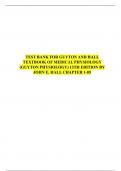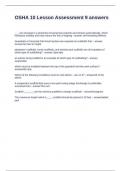TEST BANK FOR GUYTON AND HALL
TEXTBOOK OF MEDICAL PHYSIOLOGY
(GUYTON PHYSIOLOGY) 13TH EDITION BY
JOHN E. HALL CHAPTER 1-85
,Maximum volume of air expired from the maximum inspiratory level
A. Total lung capacity
B. Vital capacity
C. Inspiratory capacity
D. Functional residual capacity - (ANSWER)
Which of the following is not one of the major components of respiration
A. pulmonary ventilation, which means the inflow and outflow of air between the atmosphere
and the lung alveoli
B. diffusion of oxygen (O2) and carbon dioxide (CO2) between the alveoli and the tissue
C. transport of oxygen and carbon dioxide in the blood and body fluids to and from the body's
tissue cells
D. regulation of ventilation and other facets of respiration. - (ANSWER)B.
- The main functions of respiration are to provide oxygen to the tissues and remove carbon
dioxide. The four major components of respiration are (1) pulmonary ventilation, which means
the inflow and outflow of air between the atmosphere and the lung alveoli; (2) diffusion of
oxygen (O2) and carbon dioxide (CO2) between the alveoli and the blood; (3) transport of
oxygen and carbon dioxide in the blood and body fluids to and from the body's tissue cells; and
(4) regulation of ventilation and other facets of respiration.
(Hall 497)
,Hall, John. Guyton and Hall Textbook of Medical Physiology, 13th Edition. Saunders, 060115.
VitalBook file.
During inspiration,
A. contraction of the diaphragm pulls the lower surfaces of the lungs downward
B. the diaphragm simply relaxes, and the elastic recoil of the lungs, chest wall, and abdominal
structures compresses the lungs - (ANSWER)A.
- The lungs can be expanded and contracted in two ways: (1) by downward and upward
movement of the diaphragm to lengthen or shorten the chest cavity, and (2) by elevation and
depression of the ribs to increase and decrease the anteroposterior diameter of the chest cavity
- Normal quiet breathing is accomplished almost entirely by the first method, that is, by
movement of the diaphragm. During inspiration, contraction of the diaphragm pulls the lower
surfaces of the lungs downward. Then, during expiration, the diaphragm simply relaxes, and the
elastic recoil of the lungs, chest wall, and abdominal structures compresses the lungs and expels
the air. During heavy breathing, however, the elastic forces are not powerful enough to cause the
necessary rapid expiration, so extra force is achieved mainly by contraction of the abdominal
muscles, which pushes the abdominal contents upward against the bottom of the diaphragm,
thereby compressing the lungs.
(Hall 497)
Hall, John. Guyton and Hall Textbook of Medical Physiology, 13th Edition. Saunders, 060115.
VitalBook file.
When the rib cage is elevated, however, the ribs project almost directly forward, so the sternum
also moves forward, away from the spine, making the anteroposterior thickness of the chest
about ___ percent greater during maximum inspiration than during expiration.
A. 10
B. 20
C. 30
D. 40 - (ANSWER)B. 20
The most important muscle that raise the ribcage
A. External intercostals
, B. Sternocleidomastoid
C. Anterior serrati
D. Scaleni - (ANSWER)A. External intercostals
- he most important muscles that raise the rib cage are the external intercostals, but others that
help are the (1) sternocleidomastoid muscles, which lift upward on the sternum; (2) anterior
serrati, which lift many of the ribs; and (3) scaleni, which lift the first two ribs.
The muscles that pull the rib cage downward during expiration are mainly (1) the abdominal
recti, which have the powerful effect of pulling downward on the lower ribs at the same time that
they and other abdominal muscles also compress the abdominal contents upward against the
diaphragm, and (2) the internal intercostals.
- As they contract, they pull the upper ribs forward in relation to the lower ribs, which causes
leverage on the ribs to raise them upward, thereby causing inspiration. The internal intercostals
function exactly in the opposite manner, functioning as expiratory muscles because they angle
between the ribs in the opposite direction and cause opposite leverage.
(Hall 497)
Hall, John. Guyton and Hall Textbook of Medical Physiology, 13th Edition. Saunders, 060115.
VitalBook file.
True or false
The lungs is attached to the thoracic cavity - (ANSWER)False
- The lung is an elastic structure that collapses like a balloon and expels all its air through the
trachea whenever there is no force to keep it inflated. Also, there are no attachments between the
lung and the walls of the chest cage, except where it is suspended at its hilum from the
mediastinum, the middle section of the chest cavity. Instead, the lung "floats" in the thoracic
cavity, surrounded by a thin layer of pleural fluid that lubricates movement of the lungs within
the cavity. Further, continual suction of excess fluid into lymphatic channels maintains a slight
suction between the visceral surface of the lung pleura and the parietal pleural surface of the
thoracic cavity. Therefore, the lungs are held to the thoracic wall as if glued there, except that
they are well lubricated and can slide freely as the chest expands and contracts.
(Hall 497-498)
Hall, John. Guyton and Hall Textbook of Medical Physiology, 13th Edition. Saunders, 060115.
VitalBook file.





